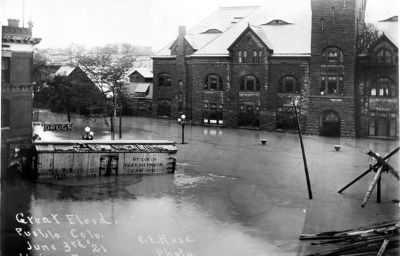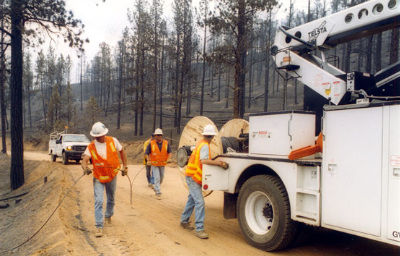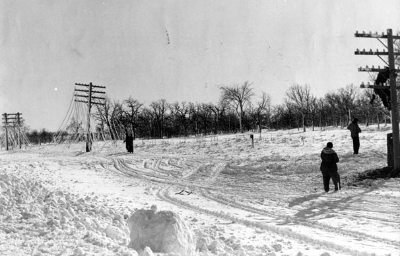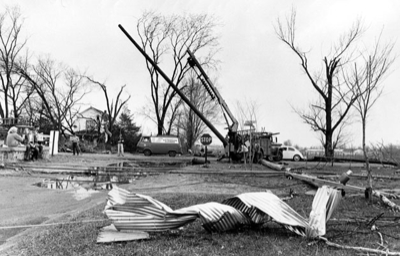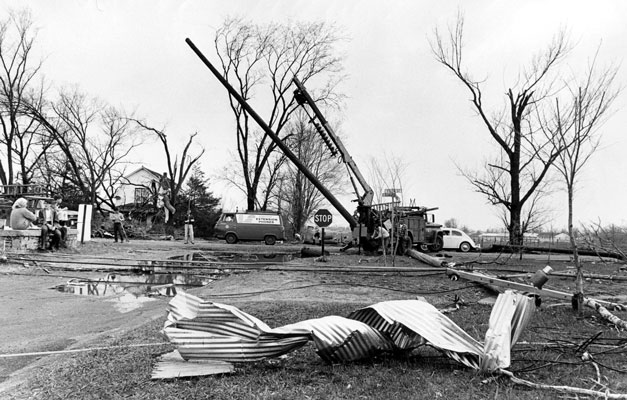
Online Exhibits
Response to Disasters
Disaster strikes somewhere in the U.S. every day, whether it’s a fire that destroys one family’s home or a hurricane that wreaks havoc along the entire East Coast. Since its beginnings, the employees of the telecommunications industry have responded to disaster with heroism, providing emergency communications systems and restoring service to citizens.
Some of them have been awarded medals (see Vail Medals


Definition
The Vail Medal
The Vail Medal was created in 1920 in memory of Theodore N. Vail (President of the American Telephone and Telegraph Company from 1907 to 1919) to perpetuate his ideals of service to the public. The medal, which bears his likeness, was awarded to individuals for noteworthy acts reflecting the Bell System's highest traditions of loyalty and devotion to duty.
Adolph Alexander Weinman, one of the leading sculptors in the United States, designed the Vail Medal in 1921. In designing the medal, Mr. Weinman captured not only the personality of Vail, but also his ideals of service to the public.
The face of the medal bears a portrait of Vail, while on the reverse, the central figure represents the "Civilizing Force of Communication" speeding the winged message along the wires. At the right, "Loyalty to Service" upholds the left hand of the central figure, while a third figure, "Devotion to Duty," helps to support the lines of communication.
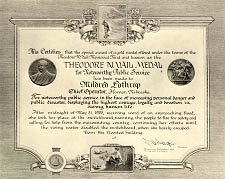 There are three types of Vail Medals: bronze, silver, and gold. Bronze medals were awarded to individuals in each Bell System company by that company's awards committee. A Bell System Committee then reviewed these cases and selected those of "especially outstanding excellence or importance" for silver or gold medal awards.
There are three types of Vail Medals: bronze, silver, and gold. Bronze medals were awarded to individuals in each Bell System company by that company's awards committee. A Bell System Committee then reviewed these cases and selected those of "especially outstanding excellence or importance" for silver or gold medal awards.
A bronze medal was also awarded to groups of employees where the noteworthy act was due to the concerted action of the group, rather than by an individual.
An embossed citation certificate, with a brief description of the circumstances that occasioned the award, was given to each Vail Medal recipient. (The one pictured is Millie Lothrop's.) A bronze plaque commemorating the act was presented to the company concerned. These plaques were designed for display in telephone buildings as a permanent and public memorial. Plaques may be seen to this day in telephone company buildings across the nation.
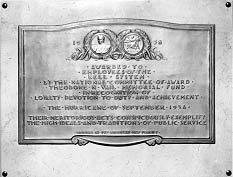 Up to the breakup of the Bell System in 1984, hundreds of awards were made to telephone company employees who embodied the ideal of service (see Heroes for some representative stories). Men and women of the Bell System performed acts of public service and bravery ranging from struggling through a blizzard to fix a downed line; saving a child from a burning building or a man from a raging flood; to staying at the switchboard while bullets flew—and were celebrated with the award of a Vail medal.
Up to the breakup of the Bell System in 1984, hundreds of awards were made to telephone company employees who embodied the ideal of service (see Heroes for some representative stories). Men and women of the Bell System performed acts of public service and bravery ranging from struggling through a blizzard to fix a downed line; saving a child from a burning building or a man from a raging flood; to staying at the switchboard while bullets flew—and were celebrated with the award of a Vail medal.
|
|
|
||||||
|
|
|

Online Exhibits
Response to Disasters
Disaster strikes somewhere in the U.S. every day, whether it’s a fire that destroys one family’s home or a hurricane that wreaks havoc along the entire East Coast. Since its beginnings, the employees of the telecommunications industry have responded to disaster with heroism, providing emergency communications systems and restoring service to citizens.
Some of them have been awarded medals (see Vail Medals


Definition
The Vail Medal
The Vail Medal was created in 1920 in memory of Theodore N. Vail (President of the American Telephone and Telegraph Company from 1907 to 1919) to perpetuate his ideals of service to the public. The medal, which bears his likeness, was awarded to individuals for noteworthy acts reflecting the Bell System's highest traditions of loyalty and devotion to duty.
Adolph Alexander Weinman, one of the leading sculptors in the United States, designed the Vail Medal in 1921. In designing the medal, Mr. Weinman captured not only the personality of Vail, but also his ideals of service to the public.
The face of the medal bears a portrait of Vail, while on the reverse, the central figure represents the "Civilizing Force of Communication" speeding the winged message along the wires. At the right, "Loyalty to Service" upholds the left hand of the central figure, while a third figure, "Devotion to Duty," helps to support the lines of communication.
 There are three types of Vail Medals: bronze, silver, and gold. Bronze medals were awarded to individuals in each Bell System company by that company's awards committee. A Bell System Committee then reviewed these cases and selected those of "especially outstanding excellence or importance" for silver or gold medal awards.
There are three types of Vail Medals: bronze, silver, and gold. Bronze medals were awarded to individuals in each Bell System company by that company's awards committee. A Bell System Committee then reviewed these cases and selected those of "especially outstanding excellence or importance" for silver or gold medal awards.
A bronze medal was also awarded to groups of employees where the noteworthy act was due to the concerted action of the group, rather than by an individual.
An embossed citation certificate, with a brief description of the circumstances that occasioned the award, was given to each Vail Medal recipient. (The one pictured is Millie Lothrop's.) A bronze plaque commemorating the act was presented to the company concerned. These plaques were designed for display in telephone buildings as a permanent and public memorial. Plaques may be seen to this day in telephone company buildings across the nation.
 Up to the breakup of the Bell System in 1984, hundreds of awards were made to telephone company employees who embodied the ideal of service (see Heroes for some representative stories). Men and women of the Bell System performed acts of public service and bravery ranging from struggling through a blizzard to fix a downed line; saving a child from a burning building or a man from a raging flood; to staying at the switchboard while bullets flew—and were celebrated with the award of a Vail medal.
Up to the breakup of the Bell System in 1984, hundreds of awards were made to telephone company employees who embodied the ideal of service (see Heroes for some representative stories). Men and women of the Bell System performed acts of public service and bravery ranging from struggling through a blizzard to fix a downed line; saving a child from a burning building or a man from a raging flood; to staying at the switchboard while bullets flew—and were celebrated with the award of a Vail medal.
